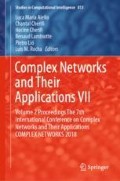Abstract
Due to the heterogeneities in the nature of complex networks, it is possible that the relationship between tie strength and network topology does not follow a universal rule. Since networks are shaped by different mechanisms, the correlation of the network topology and tie strengths can either constrain or facilitate the information flow in the networks, and the global role of strong and weak ties can differ from network to network. The theory of strength of weak ties and the global efficiency principle offer two alternative lenses in explaining tie strength and network topology. We aim at investigating these two contrasting theories by exploring the relationship between tie strength and net-work topology in online communities of practice. Our research context is the online community platform created by SAP, the largest enterprise software vendor. We use two-way fixed-effects panel data models to examine the relationship between tie strength and network topology, and the results provide support for the strength of weak ties theory.
Access this chapter
Tax calculation will be finalised at checkout
Purchases are for personal use only
References
Grabowicz, P.A., Ramasco, J.J., Moro, E., Pujol, J.M., Eguiluz, V.M.: Social features of online networks: The strength of intermediary ties in online social media. PLoS One 7(1) (2012)
Granovetter, M.S.: The strength of weak ties. Am. J. Sociol. 78(6), 1360–1380 (1973)
Onnela, J.P., Saramäki, J., Hyvönen, J., Szabó, G., Lazer, D., Kaski, K., Kertész, J., Barabási, A.L.: Structure and tie strengths in mobile communication networks. PNAS 104(18), 7332–7336 (2007)
Burt, R.S.: Structural holes versus network closure as social capital. In: Social Capital: Theory and Research, pp. 31–56 (2000)
Aral, S., Van Alstyne, M.: The diversity-bandwith trade-off. Am. J. Sociol. 117(1), 90–171 (2011)
Barrat, A., Barthélemy, M., Pastor-Satorras, R., Vespignani, A.: The architecture of complex weighted networks. PNAS 101(11), 3747–3751 (2004)
Toroczkai, Z., Bassler, K.E.: Network dynamics: Jamming is limited in scale-free systems. Nature 428(6984), 716 (2004)
Huang, P., Tafti, A.R., Mithas, S.: Platform sponsor’s investments and user contributions in knowledge communities: The role of knowledge seeding. MIS Q. 42(1), 213–240 (2018)
Pappalardo, L., Rossetti, G., Pedreschi, D.: How well do we know each other? Detecting tie strength in multidimensional social networks. Social Networks Analysis and Mining (ASONAM), pp. 1040–1045. IEEE, New York (2012)
Noka, E., Hoxha, F.: Comparative analysis of the structural and weighted properties in Albanian social networks. J. Multidiscip. Eng. Sci. Technol. 3(4), 4505–4509 (2016)
Pan, R.K., Saramäki, J.: The strength of strong ties in scientific collaboration networks. EPL (Europhys. Lett.) 97(1), 18007 (2012)
Hamilton, D., Odetunde, O., Young, K.: Investigating conversation connectivity in politically- and socially-charged Twitter discussions (2014)
Latora, V., Marchiori, M.: Efficient behavior of small-world networks. Phys. Rev. Lett. 87(19), 198701 (2001)
Goh, K.I., Kahng, B., Kim, D.: Universal behavior of load distribution in scale-free networks. Phys. Rev. Lett. 87(27), 278701 (2001)
Colizza, V., Barrat, A., Barthelemy, M., Vespignani, A.: The role of the airline transportation network in the prediction and predictability of global epidemics. PNAS 103(7), 2015–2020 (2006)
Van der Leij, M., Goyal, S.: Strong ties in a small world. Review of Network Economics 10(2), (2011)
Borgatti, S.P., Everett, M.G.: Models of core/periphery structures. Soc. Netw. 21(4), 375–395 (2000)
Girvan, M., Newman, M.E.J.: Community structure in social and biological networks. PNAS 99(12), 7821–7826 (2002)
Author information
Authors and Affiliations
Corresponding author
Editor information
Editors and Affiliations
Rights and permissions
Copyright information
© 2019 Springer Nature Switzerland AG
About this paper
Cite this paper
Basak, E., Tafti, A., Huang, P. (2019). Network Topology and Tie Strength in Online Communities of Practice. In: Aiello, L., Cherifi, C., Cherifi, H., Lambiotte, R., Lió, P., Rocha, L. (eds) Complex Networks and Their Applications VII. COMPLEX NETWORKS 2018. Studies in Computational Intelligence, vol 813. Springer, Cham. https://doi.org/10.1007/978-3-030-05414-4_30
Download citation
DOI: https://doi.org/10.1007/978-3-030-05414-4_30
Published:
Publisher Name: Springer, Cham
Print ISBN: 978-3-030-05413-7
Online ISBN: 978-3-030-05414-4
eBook Packages: Intelligent Technologies and RoboticsIntelligent Technologies and Robotics (R0)

